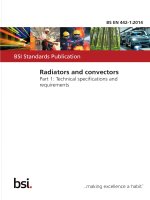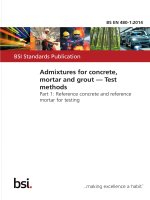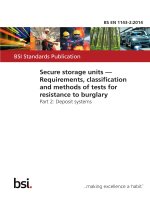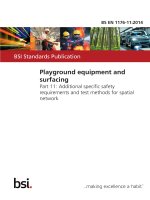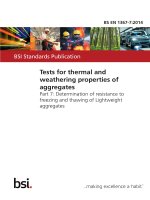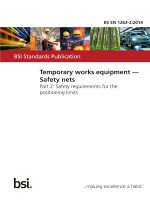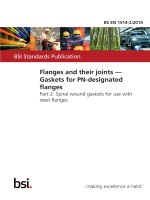Bsi bs en 61970 552 2014
Bạn đang xem bản rút gọn của tài liệu. Xem và tải ngay bản đầy đủ của tài liệu tại đây (1.3 MB, 34 trang )
BS EN 61970-552:2014
BSI Standards Publication
Energy Management
System Application
Program Interface
(EMS-API)
Part 552: CIMXML Model
Exchange Format
BRITISH STANDARD
BS EN 61970-552:2014
National foreword
This British Standard is the UK implementation of EN 61970-552:2014. It is
identical to IEC 61970-552:2013.
The UK participation in its preparation was entrusted to Technical
Committee PEL/57, Power systems management and associated
information exchange.
A list of organizations represented on this committee can be obtained on
request to its secretary.
This publication does not purport to include all the necessary provisions of
a contract. Users are responsible for its correct application.
© The British Standards Institution 2014.
Published by BSI Standards Limited 2014
ISBN 978 0 580 75930 7
ICS 33.200
Compliance with a British Standard cannot confer immunity from
legal obligations.
This British Standard was published under the authority of the
Standards Policy and Strategy Committee on 31 March 2014.
Amendments/corrigenda issued since publication
Date
Text affected
BS EN 61970-552:2014
EN 61970-552
EUROPEAN STANDARD
NORME EUROPÉENNE
EUROPÄISCHE NORM
March 2014
ICS 33.200
English version
Energy Management System Application Program Interface (EMS-API) Part 552: CIMXML Model Exchange Format
(IEC 61970-552:2013)
Interface de programmation d’application
pour système de gestion d'énergie (EMSAPI) Partie 552: Format d’échange de modèle
CIMXML
(CEI 61970-552:2013)
Schnittstelle für Anwendungsprogramme
für Netzführungssysteme (EMS-API) Teil 552: CIM-XML-Modell
Austauschformat
(IEC 61970-552:2013)
This European Standard was approved by CENELEC on 2013-12-03. CENELEC members are bound to comply
with the CEN/CENELEC Internal Regulations which stipulate the conditions for giving this European Standard
the status of a national standard without any alteration.
Up-to-date lists and bibliographical references concerning such national standards may be obtained on
application to the CEN-CENELEC Management Centre or to any CENELEC member.
This European Standard exists in three official versions (English, French, German). A version in any other
language made by translation under the responsibility of a CENELEC member into its own language and notified
to the CEN-CENELEC Management Centre has the same status as the official versions.
CENELEC members are the national electrotechnical committees of Austria, Belgium, Bulgaria, Croatia, Cyprus,
the Czech Republic, Denmark, Estonia, Finland, Former Yugoslav Republic of Macedonia, France, Germany,
Greece, Hungary, Iceland, Ireland, Italy, Latvia, Lithuania, Luxembourg, Malta, the Netherlands, Norway, Poland,
Portugal, Romania, Slovakia, Slovenia, Spain, Sweden, Switzerland, Turkey and the United Kingdom.
CENELEC
European Committee for Electrotechnical Standardization
Comité Européen de Normalisation Electrotechnique
Europäisches Komitee für Elektrotechnische Normung
CEN-CENELEC Management Centre: Avenue Marnix 17, B - 1000 Brussels
© 2014 CENELEC -
All rights of exploitation in any form and by any means reserved worldwide for CENELEC members.
Ref. No. EN 61970-552:2014 E
BS EN 61970-552:2014
EN 61970-552:2014
-2-
Foreword
The text of document 57/1386/FDIS, future edition 1 of IEC 61970-552, prepared by IEC/TC 57,
"Power systems management and associated information exchange" was submitted to the IECCENELEC parallel vote and approved by CENELEC as EN 61970-552:2014.
The following dates are fixed:
•
latest date by which the document has
to be implemented at national level by
publication of an identical national
standard or by endorsement
(dop)
2014-09-21
•
latest date by which the national
standards conflicting with the
document have to be withdrawn
(dow)
2016-12-03
Attention is drawn to the possibility that some of the elements of this document may be the subject of
patent rights. CENELEC [and/or CEN] shall not be held responsible for identifying any or all such
patent rights.
Endorsement notice
The text of the International Standard IEC 61970-552:2013 was approved by CENELEC as a
European Standard without any modification.
BS EN 61970-552:2014
EN 61970-552:2014
-3-
Annex ZA
(normative)
Normative references to international publications
with their corresponding European publications
The following documents, in whole or in part, are normatively referenced in this document and are
indispensable for its application. For dated references, only the edition cited applies. For undated
references, the latest edition of the referenced document (including any amendments) applies.
NOTE When an international publication has been modified by common modifications, indicated by (mod), the relevant EN/HD
applies.
Publication
Year
IEC 60050
Title
EN/HD
Year
Series International Electrotechnical Vocabulary
(IEV)
-
-
IEC 61968-11
-
Application integration at electric utilities System interfaces for distribution
management Part 11: Common information model (CIM)
extensions for distribution
EN 61968-11
-
IEC/TS 61970-2
-
Energy management system application
program interface (EMS-API) Part 2: Glossary
CLC/TS 61970-2
-
IEC 61970-301
-
Energy management system application
program interface (EMS-API) - Part 301:
Common information model (CIM) base
EN 61970-301
-
IEC 61970-501
-
Energy management system application
EN 61970-501
program interface (EMS-API) Part 501: Common Information Model
Resource Description Framework (CIM RDF)
schema
-
W3C
-
Document Object Model (DOM)
-
-
W3C
-
RDF/XML Syntax Specification
-
-
W3C
-
Extensible Markup Language (XML) 1.0
-
-
W3C
-
XSL Transformations (XSLT)
-
-
–2–
BS EN 61970-552:2014
61970-552 © IEC:2013
CONTENTS
INTRODUCTION ..................................................................................................................... 5
1
Scope .............................................................................................................................. 6
2
Normative references ....................................................................................................... 6
3
Terms and definitions....................................................................................................... 7
4
Model exchange header ................................................................................................... 9
5
4.1
General .............................................................................................................. 9
4.2
CIMXML documents and headers ....................................................................... 9
4.3
Model and header data description ................................................................... 10
4.4
Work flow ......................................................................................................... 12
Object identification ....................................................................................................... 13
6
5.1
URIs as identifiers ............................................................................................ 13
5.2
About rdf:ID and rdf:about ................................................................................ 14
5.3
CIMXML element identification ......................................................................... 14
CIMXML format rules and conventions ........................................................................... 15
6.1
6.2
General ............................................................................................................ 15
Simplified RDF syntax ...................................................................................... 16
6.2.1
General........................................................................................... 16
6.2.2
Notation .......................................................................................... 16
6.2.3
Syntax definition ............................................................................. 16
6.2.4
Syntax extension for difference model ............................................. 21
6.3
CIMXML format style guide ............................................................................... 26
6.4
Representing new, deleted and changed objects as CIMXML elements ............. 27
6.5
CIM RDF schema generation with CIM profile ................................................... 27
6.6
CIM extensions ................................................................................................ 28
6.7
RDF simplified syntax design rationale ............................................................. 28
Bibliography .......................................................................................................................... 30
Figure 1 – Model with header ................................................................................................ 10
Figure 2 – Example work flow events ..................................................................................... 12
Figure 3 – Example work flow events with more dependencies............................................... 13
Figure 4 – CIMXML-based power system model exchange mechanism .................................. 15
Figure 5 – Relations between UML, profile and CIMXML tools ................................................ 28
Table 1 – Header attributes ................................................................................................... 11
BS EN 61970-552:2014
61970-552 © IEC:2013
–5–
INTRODUCTION
This International standard is part of the IEC 61970 series that define an Application Program
Interface (API) for an Energy Management System (EMS).
IEC 61970-301 specifies a Common Information Model (CIM): a logical view of the physical
aspects of an electric utility operations. The CIM is described using the Unified Modelling
Language (UML), a language used to specify, visualize, and document systems in an objectoriented manner. UML is an analysis and design language; it is not a programming language.
In order for software programs to use the CIM, it must be transformed into a schema form that
supports a programmable interface.
IEC 61970-501 describes the translation of the CIM in UML form into a machine readable
format as expressed in the Extensible Markup Language (XML) representation of that schema
using the Resource Description Framework (RDF) Schema specification language.
IEC 61970-552 specifies how the CIM RDF schema specified in IEC 61970-501 is used to
exchange power system models using XML (referred to as CIMXML) defined in the 61970-45x
series of profile standards, such as the CIM Transmission Network Model Exchange Profile
described in IEC 61970-452.
–6–
BS EN 61970-552:2014
61970-552 © IEC:2013
ENERGY MANAGEMENT SYSTEM APPLICATION
PROGRAM INTERFACE (EMS-API) –
Part 552: CIMXML Model exchange format
1
Scope
This International Standard specifies a Component Interface Specification (CIS) for Energy
Management Systems Application Program Interfaces. This part specifies the format and rules
for exchanging modelling information based upon the CIM. It uses the CIM RDF Schema
presented in IEC 61970-501 as the meta-model framework for constructing XML documents of
power system modelling information. The style of these documents is called CIMXML format.
Model exchange by file transfer serves many useful purposes. Profile documents such as
IEC 61970-452 and other profiles in the 61970-45x series of standards explain the
requirements and use cases that set the context for this work. Though the format can be used
for general CIM-based information exchange, specific profiles (or subsets) of the CIM are
identified in order to address particular exchange requirements. The initial requirement driving
the solidification of this specification is the exchange of transmission network modelling
information for power system security coordination.
This standard supports a mechanism for software from independent suppliers to produce and
consume CIM described modelling information based on a common format. The proposed
solution:
•
is both machine readable and human readable, although primarily intended for
programmatic access,
•
can be accessed using any tool that supports the Document Object Model (DOM) and other
standard XML application program interfaces,
•
is self-describing,
•
takes advantage of current World Wide Web Consortium (W3C) recommendations.
This document is the Level 2 Component Interface Specification document that describes in
narrative terms (with text and examples based on the CIM) the detailed definition of the
CIMXML format.
2
Normative references
The following documents, in whole or in part, are normatively referenced in this document and
are indispensable for its application. For dated references, only the edition cited applies. For
undated references, the latest edition of the referenced document (including any amendments)
applies.
IEC 60050 series, International Electrotechnical Vocabulary
IEC 61968-11, Application integration at electric utilities – System interfaces for distribution
management – Part 11: Common information model (CIM) extensions for distribution
IEC/TS 61970-2, Energy management system application program interface (EMS-API) –
Part 2: Glossary
IEC 61970-301, Energy management system application program interface (EMS-API) – Part
301: Common information model (CIM) base
BS EN 61970-552:2014
61970-552 © IEC:2013
–7–
IEC 61970-501, Energy management system application program interface (EMS-API) – Part
501: Common Information Model Resource Description Framework (CIM RDF) schema
W3C: RDF/XML Syntax Specification
W3C: Extensible Markup Language (XML) 1.0
W3C: XSL Transformations (XSLT)
W3C: Document Object Model (DOM)
3
Terms and definitions
For the purposes of this International Standard, the terms and definitions contained in
IEC 60050 (for general glossary) and IEC 61970-2 (for EMS-API glossary definitions), as well
as the following apply.
3.1
Application Program Interface
API
set of public functions provided by an executable application component for use by other
executable application components
3.2
Common Information Model
CIM
abstract model that represents all the major objects in an electric utility enterprise typically
contained in an EMS information model
Note 1 to entry: By providing a standard way of representing power system resources as object classes and
attributes, along with their relationships, the CIM facilitates the integration of EMS applications developed
independently by different vendors, between entire EMS systems developed independently, or between an EMS
system and other systems concerned with different aspects of power system operations, such as generation or
distribution management.
3.3
CIMXML
serialisation format for exchange of XML data as defined in this document
3.4
Document Object Model
DOM
platform- and language-neutral interface defined by the World Wide Web Consortium (W3C)
that allows programs and scripts to dynamically access and exchange the content, structure
and style of documents
3.5
Document Type Definition
DTD
standard for describing the vocabulary and syntax associated with an XML document
Note 1 to entry: XML Schema and RDF are other forms that can be used.
3.6
Energy Management System
EMS
computer system comprising a software platform providing basic support services and a set of
applications providing the functionality needed for the effective operation of electrical
–8–
BS EN 61970-552:2014
61970-552 © IEC:2013
generation and transmission facilities so as to assure adequate security of energy supply at
minimum cost
3.7
Hypertext Markup Language
HTML
mark-up language used to format and present information on the Web
3.8
model
collection of data describing objects or entities real or computed
Note 1 to entry: In the context of CIM the semantics of the data is defined by profiles; refer to 3.9.
Note 2 to entry: In power system analysis, a model is a set of static data describing the power system. Examples of
Models include the Static Network Model, the Topology Solution, and the Network Solution produced by a power
flow or state estimator application.
3.9
profile
schema that defines the structure and semantics of a model that may be exchanged
Note 1 to entry: A Profile is a restricted subset of the more general CIM.
3.10
profile document
collection of profiles intended to be used together for a particular business purpose
3.11
Resource Description Framework
RDF
language recommended by the W3C for expressing metadata that machines can process
simply
Note 1 to entry: RDF uses XML as its encoding syntax.
3.12
RDF Schema
schema specification language expressed using RDF to describe resources and their
properties, including how resources are related to other resources, which is used to specify an
application-specific schema
3.13
Real-World Object
objects that belong to the real world problem domain as distinguished from interface objects
and controller objects within the implementation
Note 1 to entry: The real-world objects for the EMS domain are defined as classes in IEC 61970-301 Common
Information Model.
Note 2 to entry: Classes and objects model what is in a power system that needs to be represented in a common
way to EMS applications. A class is a description of an object found in the real world, such as a PowerTransformer,
GeneratingUnit, or Load that needs to be represented as part of the overall power system model in an EMS. Other
types of objects include things such as schedules and measurements that EMS applications also need to process,
analyze, and store. Such objects need a common representation to achieve the purposes of the EMS-API standard
for plug-compatibility and interoperability. A particular object in a power system with a unique identity is modeled as
an instance of the class to which it belongs.
BS EN 61970-552:2014
61970-552 © IEC:2013
–9–
3.14
Standard Generalized Markup Language
SGML
international standard for the definition of device-independent, system-independent methods of
representing texts in electronic form
Note 1 to entry: HTML and XML are derived from SGML.
3.15
Unified Modeling Language
UML
object-oriented modeling language and methodology for specifying, visualizing, constructing,
and documenting the artifacts of a system-intensive process
3.16
Uniform Resource Identifier
URI
Web standard syntax and semantic for identifying (referencing) resources (things, such as
files, documents, images).
3.17
eXtensible Markup Language
XML
subset of Standard Generalized Markup Language (SGML), ISO 8879, for putting structured
data in a text file
Note 1 to entry: This is an endorsed recommendation from the W3C. It is license-free, platform-independent and
well-supported by many readily available software tools.
3.18
eXtensible Stylesheet Language
XSL
language for expressing stylesheets for XML documents
4
4.1
Model exchange header
General
Model exchange typically involves the exchange of a collection of documents, each of which
contains instance data (referred to as a model) and a header. The structure and semantics of
each model are described by a profile, which is not included in the exchanged data. The overall
exchange is governed by a collection of profiles in a Profile Document.
A header describes the content of the model contained in a document e.g. the date the model
was created, description etc. The header may also identify other models and their relationship
to the present model. Such information is important when the models are part of a work flow
where, for example, the models have relations to each other, e.g. a model succeeds and/or
depends on another.
Subclauses 4.2 to 4.4 define the model with header data and work flow it is designed to
support.
4.2
CIMXML documents and headers
A CIMXML document is described by a single header. Multiple headers in a CIMXML document
are not allowed. Hence instance data in a CIMXML document adhere to a single profile.
– 10 –
BS EN 61970-552:2014
61970-552 © IEC:2013
In case multiple and possibly related CIMXML documents need to be kept together they shall
be collected in an archive, e.g. zip.
4.3
Model and header data description
A description of a model is attached as header data to the model. Figure 1 describes the model
with header information.
class Header Model
Model
+Depending 0..*
+DependentOn 0..*
+SupersededBy 0..*
+Supersedes 0..*
+
+
+
+
+
+
created :DateTime
scenarioTime :DateTime
description :String
modelingAuthoritySet :URI [0..1]
profile :URI [1..*]
version :String
«Primitive»
URI
{root}
FullModelDocumentElement
DifferenceModel
+forwardDifferences
Statements
0..1
FullModel
+reverseDifferences
0..1
IEC 2767/13
Figure 1 – Model with header
In Figure 1 the classes FullModel, DifferenceModel and Statements describe the model data
while the header is described by the classes Model and Description. The following is a bottom
up description of these classes:
•
The FullModelDocumentElement class represents any of the elements that may appear in a
full model document. It has the two sub types Statements or FullModel, both are further
described below. A full model document typically contains one FullModel element and one
set of Definition elements.
•
The Statements class represent a set of Definition (refer to 6.2.3.5) and/or Description
(refer to 6.2.3.6) elements.
•
The FullModel (refer to 6.2.3.4) class represent the full model header and its contents is
described by the Model class.
•
The DifferenceModel (refer to 6.2.4.6) class represents the difference model header. The
content is described by the Model class, the association role forwardDifferences and
association role reverseDifferences. Both association roles may have one set of
Statements.
•
The Model class describes the header content that is the same for the FullModel and the
DifferenceModel. A Model is identified by an rdf:about attribute. The rdf:about attribute
uniquely describe the model and not the document where the header exists. Hence multiple
documents created from the same unchanged data model will have the same rdf:about.
This also means that a model change result in a new rdf:about next time a document is
created.
BS EN 61970-552:2014
61970-552 © IEC:2013
– 11 –
The Model class attributes are described in Table 1.
Table 1 – Header attributes
Class
Attribute
Description
Model
created
The date when the model was created (note this is typically not when the
CIMXML document was created which is after this time).
Model
scenarioTime
The date and time that the model represents, e.g. the current time for an
operational model, a historical model or a future planned model.
Model
description
A description of the model, .e.g. the name of person that created the
model and for what purpose.
Model
modelingAuthoritySet
A URN describing the equipment model sourcing the data in a CIMXML
document, e.g. a model for the whole or a part of a country.
Model
profile
A URN describing the Profiles that governs this model. It uniquely
identifies the Profile and its version.
Model
version
A description of the version of the model sourcing the data in a CIMXML
document. Examples are
–
Variations of the equipment model for the ModelingAuthoritySet
–
Different study cases resulting in different solutions.
The version attribute is a custom string that is changed in synchronisation
with the rdf:about identifier, refer to description of the Model class above.
Model
DependentOn
A reference to the models that the model described by this document
depends on, e.g.
–
A load flow solution depends on the topology model it was computed
from
–
A topology model computed by a topology processor depends on the
network model it was computed from.
Model
Depending
All models depending on this model. This role is not intended to be
included in any document exchanging instance data.
Model
Supersedes
When a model is updated the resulting model supersedes the models that
were used as basis for the update. Hence this is a reference to CIMXML
documents describing the updated models.
Model
SupersededBy
All models superseding this model. This role is not intended to be
included in any document exchanging instance data.
The profile attribute is a URI having the following format:
>
e.g. />The UML in Figure 1 translates into CIMXML elements as follows:
1) A leaf class in Figure 1 (DifferenceModel, Statements and FullModel) appears as class
elements under the document element (6.2.3.3).
2) Statement elements appear as Definition (6.2.3.5) or Description elements (6.2.3.6).
3) Literal attributes, e.g. Model.created, appears as literal property elements (6.2.3.8).
4) Roles appear, e.g. Model.Supersedes, as resource property elements (6.2.3.10).
5) Inherited attributes and roles appear directly as elements under the leaf class following
the rules 3, 4 and 5 above.
6)
A CIMXML model document is identified by a Model rdf:about attribute (implicit in the
UML). Hence the roles DependentOn and Supersedes are references to the Model
rdf:about attribute.
BS EN 61970-552:2014
61970-552 © IEC:2013
– 12 –
7) A full model document may be regenerated multiple times from the same source data.
Full model documents regenerated from unchanged source data keep the model
identification (Model rdf:about) unchanged from the original full model document.
8) When generating a full model document superseding a differential the new full model
document will have the same model identification (Model rdf:about) as the differential if
the model is unchanged since the differential was created. Hence it is an alternate to
the differential.
4.4
Work flow
A work flow is described by a sequence of exchange events. The model description in 4.3
supports work flow events related in time with the Model.Supersedes attribute and events
related to profiles with the Model.DependentOn attribute. An example of this is shown in
Figure 2.
Equipment
Topology
State
Variables
E1
T1
S1
S2
T2
Time
E2
S3
S4
T3
E3
S5
E3
T4
S6
E4
Profile
Full model
DifferentialModel
DependentOn
Supersedes
IEC 2768/13
Figure 2 – Example work flow events
In this example, a solved network model is exchanged as a collection of models governed by a
Profile Document comprising Equipment, Topology, and State Variables documents. The left
time line in Figure 2 represents how the Equipment model document is exchanged over time.
The center time line shows how new Topology results are exchanged over time and the
Equipment models on which each depends. The right most time line shows how multiple State
Variable documents are exchanged and the Topology documents on which they depend. Also
note that the equipment model E3 is represented both by a full and an incremental document.
The situation in Figure 2 represents a simple case. A more complex situation is shown in
Figure 3.
BS EN 61970-552:2014
61970-552 © IEC:2013
– 13 –
Topology
Equipment
T1
E1
Profile
E -C
Full Model
E-A1
E -B1
TA
Differential
Model
TB
DependentOn
Supersedes
E-B2
E A2
E AB
TABa
TABb
T2b
E2
IEC 2769/13
Figure 3 – Example work flow events with more dependencies
The CIMXML documents in Figure 3 may be created from a data modeller environment where
multiple change tracks of a model appear in parallel, e.g. the equipment model has three
tracks E-Ax, E-Bx and E-C that eventually merge into the full model E2 superseding the
equipment model tracks.
A receiver of the CIMXML documents may use any of the topology documents TA, TB, TABa or
T2b with the equipment model from E2. As the sender (the data modeller in this example) only
verified T2b with E2 this is the only combination that is supposed to fit together. Concerning
T2b the receiver may choose to apply TB and TABb to T1 instead of using T2b.
5
5.1
Object identification
URIs as identifiers
UUIDs (Universally Unique IDentifier), also known as GUIDs (Globally Unique IDentifier) can be
used to identify resources in such a way that the
•
identifiers can be independently and uniquely allocated by different authorities. This is a big
advantage with the UUID.
•
identifiers are stable over time and across documents.
If, in addition, the UUID is embedded in a Uniform Resource Name (URN) then the document
can be simplified by the elimination of XML base namespace declarations (xml:base attributes).
The URN is a concise, fixed-length, absolute URI.
The standard for an URN containing a UUID is defined by the Internet Engineering Task Force
RFC 4122.
– 14 –
BS EN 61970-552:2014
61970-552 © IEC:2013
RFC 4122 specifies the syntax of the URN and how the UUID portion following the last colon is
allocated. The algorithm is aligned with, and technically compatible with, IEC 9834-8:2004
Information Technology, "Procedures for the operation of OSI Registration Authorities:
Generation and registration of Universally Unique Identifiers (UUIDs) and their use as ASN.1
Object Identifier components" ITU-T Rec. X.667, 2004.
CIMXML elements are identified by a URI. A URI can have two forms:
•
URL
•
URN
The URL and URN forms have fundamentally different structures, i.e.:
•
URL form; protocol://authority/path?query#fragment where the protocol in CIMXML is http
•
URN form: urn:namespace:specification where the namespace in CIMXML is uuid.
The URN specification format is summarized below
•
8 character hex number
•
a dash “-“
•
4 character hex number
•
a dash “-“
•
4 character hex number
•
a dash “-“
•
4 character hex number
•
a dash “-“
•
12 character hex number
where letters are lower case.
An example of the URN form is shown below
•
5.2
”urn:uuid:26cc8d71-3b7e-4cf8-8c93-8d9d557a4846”.
About rdf:ID and rdf:about
A CIMXML element can be identified by two different RDF constructs:
•
rdf:ID
•
rdf:about
The use of rdf:ID and rdf:about has a specific meaning that does not align with their definition
in RDF. The meanings are:
•
an rdf:ID specifies the life of object globally, i.e. its creation or deletion.
•
an rdf:about is a reference to an existing object.
5.3
CIMXML element identification
Object identification is so central in RDF that all elements representing objects are identified
with a rdf:ID or rdf:about XML attribute. All classes in CIM that inherit IdentifiedObject have the
UML object identification attribute IdentifiedObject.mRID. The attribute is implicitly mapped to
the rdf:ID/rdf:about XML attribute.
A CIMXML document may only use the URN form (see 5.1) as further described below.
BS EN 61970-552:2014
61970-552 © IEC:2013
– 15 –
CIMXML files contain XML elements describing CIM objects (ACLineSegments, Substations
etc.). The CIM has lots of association roles that show up as references in the XML elements
(typically as rdf:resource or rdf:about attributes). CIM data is exchanged in different CIMXML
documents that depend on each other as described in Clause 4. Some references then cross
CIMXML document boundaries. A consequence of this is that the identification of a CIM object
must be stable during its life time. Otherwise referencing objects across document boundaries
will break.
A common practice in object oriented systems is to assume all objects have an identifier that is
unique in space and time which means:
•
Different objects are assigned different identifiers.
•
Identifiers once assigned are never reused even if the original object having it is gone.
The URN form as described in 5.1 is used as CIMXML element identification with the following
differences
•
the prefix “urn:uuid:” is replaced by an underscore “_”. The underscore avoids a numeric
starting character for the non-base part of the identifier. Starting the non-base part of the
identifier with a numeric character is invalid RDF. The underscore is added in all cases to
simplify parsers, even if the UUID starts with a non-numeric character.
•
the prefix is defined as an xml:base=“urn:uuid:”
Some examples:
•
rdf:ID=”_26cc8d71-3b7e-4cf8-8c93-8d9d557a4846”.
•
rdf:about=”#_26cc8d71-3b7e-4cf8-8c93-8d9d557a4846”.
6
CIMXML format rules and conventions
6.1
General
Given the CIM RDF Schema described in IEC 61970-501, a power system model can be
converted for export as an XML document (see Figure 3). This document is referred to as a
CIMXML document. All of the tags (resource descriptions) used in the CIMXML document are
supplied by the CIM RDF schema. The resulting CIMXML model exchange document can be
parsed and the information imported into a foreign system.
Proprietary
Power System
Data
CIM
in UML
CIM RDF
Schema
RDF
Syntax
specify
reference
Importer/
Exporter
Power
System Data
as
CIM XML
IEC 2770/13
Figure 4 – CIMXML-based power system model exchange mechanism
– 16 –
6.2
BS EN 61970-552:2014
61970-552 © IEC:2013
Simplified RDF syntax
6.2.1
General
RDF syntax provides many ways to represent the same set of data. For example, an
association between two resources can be written with a resource attribute or by nesting one
element within another. This could make it difficult to use some XML tools, such as XSL
processors, with the CIMXML document.
Therefore, only a subset of the RDF Syntax is to be applied in creating CIMXML documents.
This syntax simplifies the work of implementers to construct model serialization and deserialization software, as well as to improve the effectiveness of general XML tools when used
with CIMXML documents. The reduced syntax is a proper subset of the standard RDF syntax;
thus, it can be read by available RDF de-serialization software.
The following subsections define a subset of the RDF Syntax. This simplified syntax is for
exchanging power system models between utilities. The aim of the specification is to make it
easier for implementers to construct de-serialization software for RDF data, to simplify their
choices when serializing RDF data, and to improve the effectiveness of general XML tools such
as XSLT processors when used with the serialized RDF data.
The reduced syntax is a proper subset of the standard RDF syntax. Thus, it can be read by
RDF de-serialization software such as SirPAC [8] 1. In this, it differs from other proposals for a
simplified syntax, such as [9], [10].
The reduced syntax does not sacrifice any of the power of the RDF data model. That is, any
RDF data can be exchanged using this syntax. Moreover, features of RDF such as the ability to
extend a model defined in one document with statements in second document are preserved.
6.2.2
Notation
The simplified syntax is defined in the following section. Each kind of element is defined in a
subsection beginning with a model of the element, followed by some defining text, and a
reference to the RDF grammar. The semantics of the element are not detailed (refer to the
RDF recommendation [3] for that information). The notation for the element model is as
follows:
a) A symbol in italics in the position of an element type, attribute name or attribute value
indicates the type of name or value required. The symbol will be defined in the text.
b) The symbol rdf stands for whatever namespace prefix is chosen by the implementation for
the RDF namespace. Similarly the symbol cim stands for the chosen CIM namespace
prefix.
c) A comment within the element model indicates the allowed content. A symbol in italics
stands for a kind of element or other content defined in the text. A construction (a | b)
indicates that a and b are alternatives. A construction a* indicates zero or more repetitions
of a.
d) All other text in the model is literal.
6.2.3
6.2.3.1
Syntax definition
General
The syntax definition is enriched with examples. The examples should help to get a better
understanding of the formal syntax definition. The same example is used for several syntax
definitions. The syntax focused in the example is indicated in bold.
______________
1
Numbers in square brackets refer to the bibliography.
BS EN 61970-552:2014
61970-552 © IEC:2013
6.2.3.2
– 17 –
Name space URIs defined in this specification
The following name spaces are defined in this specification:
•
cim-model-description_uri described by xmlns:md
•
difference-model-namespace-uri described by xmlns:dm
Their values are defined as:
•
•
xmlns:md =” />xmlns:dm=” />
6.2.3.3
Document element
<rdf:RDF xmlns:rdf= />xmlns:cim=”cim-namespace-uri”
xmlns:md=”cim-model-description_uri”>
<!-– Content: full-model (definition|description)* –->
</rdf:RDF>
<rdf:RDF xmlns:rdf= />xmlns:cim=”cim-namespace-uri”
xmlns:md=”cim-model-description_uri”
xml:base="urn:uuid:">
<!-– Content: full-model (definition|description)* –->
</rdf:RDF>
Example:
<?xml version="1.0" encoding="UTF-8"?>
</rdf:RDF>
a) The element type is rdf:RDF.
b) The RDF namespace must be declared as />c) The CIM namespace must be declared. With newer versions of the CIM schema the version
needs to be adjusted in the CIM name space. Parties exchanging documents have to agree
on the used version.
d) Other namespaces may be declared.
e) The xml:base attribute shall always be present, refer to 5.3.
The RDF [3] grammar clause: 6.1.
6.2.3.4
FullModel element
<md:FullModel rdf:about=model-uri>
|compound-property)* –->
</md:FullModel >
Example:
<md:FullModel rdf:about="=”#_26cc8d71-…">
<md:Model.created>2008-12-24</md:Model.created>
<md:Model.Supersedes rdf:resource="#_26cc8d71-a002-4c2b-bcf47bc97430bf87"/>
– 18 –
BS EN 61970-552:2014
61970-552 © IEC:2013
<md:Model.DependentOn rdf:resource=#_26cc8d71-a002-4c2b-bcf47bc97430bf88"/>
<md:Model.version>V32</md:Model.version>
<md:Model.modelingAuthoritySet> />Model.modelingAuthoritySet>
<md:Model.description>Santa Claus made a study case peak load summer base
topology solution</md:Model.description>
<md:Model.profile> /></md:FullModel>
1) The full model element introduces a new model.
2) The value of the about attribute, model-uri, is a name chosen by the implementation.
The model-uri uniquely identifies a document and is the name referenced by other
documents, e.g. by Supersedes or DependentOn, as indicated in Figure 2.
6.2.3.5
Definition element
<classname rdf:ID=identity>
(literal-property|resource-property|compound-property)*
-->
</classname>
<classname rdf:about=resource-uri>
(literal-property|resource-property|compound-property)*
-->
</classname>
Example:
<cim:SynchronousMachine rdf:about="#_31dcf429-6bfb-4e2e-b2996-42491b3abc1">
<cim:IdentifiedObject.name>IN-2</cim:IdentifiedObject.name>
<cim:SynchronousMachine.minimumMVAr>-9999</cim:SynchronousMachine.minimumMVAr>
<cim:SynchronousMachine.operatingMode rdf:resource=" />
<cim:Equipment.EquipmentContainer rdf:resource="#_6cb8701a-12f1-4de9-9e68125d95073a75"/>
</cim:SynchronousMachine>
a) The definition element introduces a new resource and gives its type. There are two forms:
the first as an rdf:ID attribute and the second an rdf:about attribute.
b) The element type, classname, is the XML qualified name of a class from the CIM schema
or other schema declared as a namespace in the document element.
c) The value of the id attribute, identity, is chosen by the implementation. It must be unique
in the document. (It is not necessarily related to the power system resource name.)
6.2.3.6
Description element
<rdf:Description rdf:about=resource-uri>
(literal-property|resource-property|compound-property)*
-->
</rdf:Description >
Example:
<rdf:Descriptionrdf:about="#_26cc8d71-a002-4c2b-bcf4-7bc97430bf87">
<cim:IdentifiedObject.name>TROY</cim:IdentifiedObject.name>
BS EN 61970-552:2014
61970-552 © IEC:2013
– 19 –
</rdf:Description>
a) The description element adds information about a resource introduced elsewhere in this or
another document.
b) The resource-uri is a URN-reference that identifies the subject resource.
c) The Description element is used only in difference models (refer to 6.2.4). It is never used
in full models.
6.2.3.7
Compound element
<classname>
(literal-property|resource-property|compound-property)*
-->
</classname>
Example:
<cim:DateTimeInterval>
<cim:DateTimeInterval.start>2013-02-28</cim:DateTimeInterval.start>
<cim:DateTimeInterval.end>2013-02-29</cim:DateTimeInterval.end>
</cim:DateTimeInterval>
1) The compound element introduces a structured value. The value does not represent a
resource nor have any identity. It can only appear as the object of a property.
2) The element type, classname, is the XML qualified name of a compound class.
3) A compound element is treated as an indivisible unit. Hence a compound element is not
supposed to be split in multiple elements having different sets of members. Refer also
to paragraph 6.2.4.7.4.
6.2.3.8
Literal-Property element
<!–- Content: text -->
</propname>
Example:
<cim:SynchronousMachine rdf:ID="_31dcf429-6Bfb-4e2e-b2996-42491b3abc1">
<cim:IdentifiedObject.name>IN-2</cim:IdentifiedObject.name>
<cim:SynchronousMachine.minimumMVAr>-9999</cim:SynchronousMachine.minimumMVAr>
<cim:SynchronousMachine.operatingMode rdf:resource=" /><cim:RegulatingCondEq.RegulationSchedule rdf:resource="#_ca32746f-a002-4c2bbcf4-7bc97430bf87"/>
<cim:Equipment.EquipmentContainer rdf:resource="#_6cb8701a-12f1-4de9-9e68125d95073a75"/>
</cim:SynchronousMachine>
a) The literal-property element introduces a property and a literal value applying to the
enclosing resource.
b) The element type, propname, is the XML qualified name of a property from the CIM schema
or other schema declared as a namespace in the document element.
c) The content text is any XML text with <, >, and & escaped representing the value of the
property.
d) Floating point numbers may slightly change due to rounding effects when imported and reexported again. This is allowed and need to be managed by applications, e.g. by use of a
dead band in case the values are compared.
– 20 –
6.2.3.9
BS EN 61970-552:2014
61970-552 © IEC:2013
Compound-Property element
<!–- Content: (compound) -->
</propname>
Example:
<cim:TimeSchedule>
<cim:TimeSchedule.scheduleInterval>
<cim:DateTimeInterval>
<cim:DateTimeInterval.start>2013-02-28</cim:DateTimeInterval.start>
<cim:DateTimeInterval.end>2013-02-29</cim:DateTimeInterval.end>
</cim:DateTimeInterval>
</cim:TimeSchedule.scheduleInterval>
</cim:TimeSchedule>
6.2.3.10
Resource-Property element
a) The resource-property element introduces a property and a resource as its value applying
to the enclosing resource.
b) The element type, propname, is the XML qualified name of a property from the CIM schema
or other schema declared as a namespace in the document element.
c) The resource-uri is an URN-reference that identifies a resource.
d) For relations with roles having cardinality greater than one the resource property element
shall be repeated as many times as there are references
Example 1 - URN-Reference:
The example contains two references one for a RegulationSchedule and the other to the parent represented as
EquipmentContainer.
<cim:SynchronousMachine rdf:ID="_31dcf429-6bfb-4e2e-b299-642491b3abc1">
<cim:IdentifiedObject.name>IN-2</cim:IdentifiedObject.name>
<cim:SynchronousMachine.minimumMVAr>-9999</cim:SynchronousMachine.minimumMVAr>
<cim:SynchronousMachine.operatingMode rdf:resource=" /><cim:RegulatingCondEq.RegulationSchedule rdf:resource="#_cd32746f-a002-4c2bbcf4-7bc97430bf87"/>
<cim:Equipment.EquipmentContainer rdf:resource="#_6cb8701a-12f1-4de9-9e68125d95073a75"/>
</cim:SynchronousMachine>
Example 2 - Enumeration:
The example defines the attribute value of SynchonousMachine.operatingMode as “generator”. The operatingMode
is specified in the CIM schema as the enumeration SynchronousMachineOperatingMode.
<cim:SynchronousMachine rdf:ID="_31dcf429-6bfb-4e2e-b2996-42491b3abc1" >
<cim:IdentifiedObject.name>IN-2</cim:IdentifiedObject.name>
<cim:SynchronousMachine.minimumMVAr>-9999</cim:SynchronousMachine.minimumMVAr>
<cim:SynchronousMachine.operatingMode rdf:resource=" /><cim:RegulatingCondEq.RegulationSchedule rdf:resource="#_cd32746f-a002-4c2bbcf4-7bc97430bf87"/>
<cim:Equipment.EquipmentContainer rdf:resource="#_6cb8701a-12f1-4de9-9e68125d95073a75"/>
</cim:SynchronousMachine>
BS EN 61970-552:2014
61970-552 © IEC:2013
– 21 –
The example defines the attribute value of SynchonousMachine.operatingMode as “generator”.
The
operatingMode
is
specified
in
the
CIM
schema
as
the
enumeration
SynchronousMachineOperatingMode.
Example 3 – Role with cardinality greater than one:
<cim:SynchronousMachine rdf:ID="_31dcf429-6bfb-4e2e-b299-642491b3abc1">
<cim:IdentifiedObject.name>IN-2</cim:IdentifiedObject.name>
<cim:SynchronousMachine.minimumMVAr>-9999</cim:SynchronousMachine.minimumMVAr>
<cim:SynchronousMachine.operatingMode rdf:resource=" /><cim:RegulatingCondEq.RegulationSchedule rdf:resource="#_cd32746f-a002-4c2bbcf4-7bc97430bf87"/>
<cim:Equipment.EquipmentContainer rdf:resource="#_6cb8701a-12f1-4de9-9e68125d95073a75"/>
<cim:Equipment.ReactiveCapabilityCurves rdf:resource="#_6cb8701a-12f1-4de9-9e68125d95073a76"/>
<cim:Equipment.ReactiveCapabilityCurves rdf:resource="#_6cb8701a-12f1-4de9-9e68125d95073a77"/>
<cim:Equipment.ReactiveCapabilityCurves rdf:resource="#_6cb8701a-12f1-4de9-9e68125d95073a78"/>
</cim:SynchronousMachine>
6.2.4
6.2.4.1
Syntax extension for difference model
General
The general syntax definition in the first part of this clause is used for partial and full model
data exchange. Once the initial complete set of model data is exchanged, only updates are
required to maintain the model as changes occur. In general, those changes can be specified
as a set of differences between two models. The difference document is itself an RDF model (a
collection of RDF statements) and therefore can be processed by an RDF infrastructure.
6.2.4.2
Example use case
To illustrate the difference document approach to handling incremental model updates, an
example use case is provided. In this example, the participants are Regional Energy Co. and
Network Power Co.:
•
Each participant has a copy of a power system model, B1.
•
Regional Energy Co. updates B1, to reflect forthcoming power system modifications,
producing B2.
•
Regional Energy Co. sends the differences between B1 and B2 to Network Power Co. as a
difference model.
•
Network Power Co. reviews and validates the difference model.
•
Network Power Co. merges the difference model with its copy of model B1, to produce B2.
An alternative would have been for Regional Energy Co. to simply send Network Power Co. a
copy of B2. However, B2 is a very large model and it is not feasible to validate it in any
reasonable period of time. Validation is not entirely automated, but involves analysis by
experts. Indeed, the best validation strategy for B2 may be to compare it to the previously
validated B1. This brings us back to the need for a difference model.
A more complicated use case would involve more than two participants. Several peers of
Regional Energy Co. would contribute difference models to Network Power Co. This use case
would introduce issues of parallel model changes and concurrency conflict.
– 22 –
6.2.4.3
BS EN 61970-552:2014
61970-552 © IEC:2013
Requirements
Given two RDF models, B1 and B2, called base models, the requirement is for a difference
model that:
•
Represents the differences between the two base models.
•
Is itself an RDF model (a collection of RDF statements) and therefore can be processed by
RDF infrastructure.
•
Efficiently represents a small difference between two large base models.
•
When an object is deleted, the system applying the differences is responsible for
performing the “cascading deletions” ,i.e, finding and deleting all other contained objects.
Associations with deleted objects should also be deleted.
•
Remove operations are not reversible (at least, not from the information in the difference
model).
•
May contain information about itself such as authorship, purpose and date.
•
May contain information to protect against conflicts arising when two difference models are
created concurrently from the same base model.
The requirement to treat each difference document as a database commit operation is outside
the scope of this service (i.e., a roll back functionality, if desired, is the responsibility of the
receiving application, not the sending application). This is in recognition of the fact that the
sending application may not be aware of changes made in the B2 model documents by other
agents since the last update to B1.
6.2.4.4
Structure of difference document
Given two base RDF models, B1 and B2, the difference model is made up of four groups of
statements, each encoded as a sequence of resource description structures:
•
Header statements, comprising statements about the difference model itself.
•
Forward difference statements, comprising statements found in B2, but not in B1.
•
Reverse difference statements, comprising statements found in B1, but not in B2.
•
Precondition statements, comprising statements found in both B1 and B2 and considered to
be dependencies of the difference model in an application defined sense.
Any or all of the four groups can be empty.
The difference model itself is represented by a resource of type dm:DifferenceModel. It is
conventional to use the URN of the model itself for this resource.
The following properties apply to the difference model resource:
•
dm:forwardDifferences is a property of the difference model whose value is a collection of
statements (i.e., resources of type rdf:Statement) representing the forward difference
statements.
•
dm:reverseDifferences is a property of the difference model whose value is the collection of
reverse difference statements.
•
dm:preconditions is a property of the difference model whose value is the collection of
precondition statements.
Header properties also apply to the difference model resource. These may indicate authorship,
date and purpose. These properties can be drawn from the Dublin Core vocabulary or any
other convenient schema.
The namespace for the difference model vocabulary, represented by the prefix dm: in the
foregoing, is: />
BS EN 61970-552:2014
61970-552 © IEC:2013
6.2.4.5
– 23 –
Preconditions and concurrency
The precondition statements are a subset of both B1 and B2 and carry no difference
information. In simple, sequential model revision scenarios they can be omitted.
For a large shared model, sequential revision is not always feasible. Revisions are likely to be
constructed concurrently by different participants, without reference to each other. Concurrency
issues must be handled, but the conventional database-oriented approach of using locks to
detect incompatible concurrent transactions is not feasible on a web-scale.
The precondition statements are an alternative to locks. Informally, they represent the
information that would have been read-locked in an equivalent database transaction. Software
agents that process difference models can check that the preconditions hold and, if not, warn
of incompatible model revisions.
The choice of statements to include as preconditions is application-specific (as is the choice of
which information to lock in a database transaction). Preconditions should include statements
that would affect decisions of the agent that produced the model revision.
6.2.4.6
Difference model template
The following is a template for the conventional syntax of a difference model.
<rdf:RDF xmlns:rdf=” />xmlns:cim=”cim-namespace-uri”
xmlns:md=”cim-model-description_uri”
xmlns:dm=”difference-model-namespace-uri”
xml:base=" urn:uuid:" >
<dm:DifferenceModel rdf:about=model-uri>
-->
<!-– Content: (definition|description)* –->
</dm:preconditions>
<dm:forwardDifferences parseType=”Statements”>
”>
<!-– Content: (definition|description)* –->
</dm:forwardDifferences>
<dm:reverseDifferences parseType=”Statements”>
>
<!-– Content: (definition|description)* –->
</dm:reverseDifferences>
</dm:DifferenceModel>
</rdf:RDF>
Simply for clarification with the namespace “dm” new statements are introduced that are valid
extensions to the standard RDF syntax through the new property rdf:parseType, which is called
Statements.
<!-- Content: (definition|description)* -->
</property>
The content model of an element with rdf:parseType=”Statements” is the same as the content
model of the rdf:RDF element.
The content generates the same RDF statements as if it appeared in an rdf:RDF element.
6.2.4.7
6.2.4.7.1
Difference model usage
General
The following cases explain the usage of the difference model.

